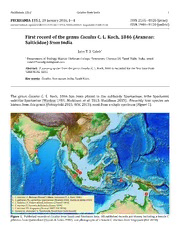
First record of the genus Cocalus C. L. Koch, 1846 (Araneae: Salticidae) from India PDF
Preview First record of the genus Cocalus C. L. Koch, 1846 (Araneae: Salticidae) from India
Peckhamia 135.1 Cocalus from India 1 PECKHAMIA 135.1, 20 January 2016, 1―4 ISSN 2161―8526 (print) ISSN 1944―8120 (online) urn:lsid:zoobank.org:pub:61881F41-CCF7-4A21-892A-7A8461090833 (registered 19 JAN 2016) First record of the genus Cocalus C. L. Koch, 1846 (Araneae: Salticidae) from India John T. D. Caleb1 1 Department of Zoology, Madras Christian College, Tambaram, Chennai-59, Tamil Nadu, India, email [email protected] Abstract: A jumping spider from the genus Cocalus C. L. Koch, 1846 is recorded for the first time from Tamil Nadu, India. Key words: Cocalus, first report, India, Tamil Nadu The genus Cocalus C. L. Koch, 1846 has been placed in the subfamily Spartaeinae, tribe Spartaeini, subtribe Spartaeina (Wanless 1984; Maddison et al. 2013, Maddison 2015). Presently four species are known from this genus (Prószyński 2015; WSC 2015), most from a single specimen (Figure 1). 6 5 1 4 3 2 1. C. concolor ♂, Bintang (Bintan?) Island, Indonesia (C. L. Koch 1846) 2. C. gibbosus ♂♀, Lockerbie, Queensland (Wanless 1981; Davies & Żabka 1989) 3. C. limbatus ♂, Ambon Island, Indonesia (Thorell 1878) 4. C. murinus ♀, Sumatra, Indonesia (Simon 1899) 5. C. murinus 2♀, Singapore (Su et al. 2007; Hill 2010) 6. Cocalus sp. immature ♀, Tambaram, Tamil Nadu (new record) Figure 1. Published records of Cocalus from South and Southeast Asia. All published records are shown, including a female C. gibbosus from Queensland (Davies & Żabka 1989), and photographs of a female C. murinus from Singapore (Hill 2010). Peckhamia 135.1 Cocalus from India 2 Two Cocalus species are from Indonesia (C. concolor C. L. Koch 1846 and C. limbatus Thorell 1878), one (C. murinus Simon 1899) from Sumatra and nearby Singapore, and one (C. gibbosus Wanless 1981) from northern Queensland. The present paper provides the first record of the genus Cocalus from the scrub jungle of Madras Christian College, Tambaram, India. This spider was photographed using a Nikon D60, 18-55mm DSLR with the lens reversed for macrophotography. It was preserved in 70% alcohol and later examined using a Carl Zeiss Stemi-4 stereomicroscope equipped with an image processing system. Material examined. 1 Sub-adult female: Madras Christian college campus, Tambaram, Tamil Nadu, INDIA, 12° 55' 16.7694" N 80° 7' 25.5576" E, altitude 32m; coll. 2 November, 2012 by John Caleb T. D. This sub-adult female Cocalus (Figures 2-13) was collected on the bark of a tree which fell after tropical cyclone Nilam hit the coastal regions of Tamil Nadu, was reared for about three months but did not survive to maturity. Examination after preservation revealed a penultimate female specimen with slight sclerotization beginning to form at the epigynal region. The genus was identified by the presence of a small bump (indicated with red arrow, Figure 5) at the center of its posterior ocular quadrangle (Wanless 1981). This character is unique for this genus. 2 3 4 5 6 7 Figures 2-7. Living sub-adult female Cocalus sp. from Tambaram, Tamil Nadu, India. Peckhamia 135.1 Cocalus from India 3 8 9 10 11 12 13 Figures 8-13. Sub-adult female Cocalus sp. from Tambaram, Tamil Nadu, India. 11-12, Ventral (11) and dorsal (12) views of the opisthosoma in life. 13, Dorsal view of opisthosoma in alcohol. Acknowledgements I am thankful to Prof. Dr. Jerzy Prószyński for valuable discussions and encouragement. I am grateful to Dr. Ganesh Vankhede for permitting the use of the Stereo-microscope facility. Thanks to the Department of Zoology, Madras Christian College, Tambaram for providing a DSLR for photographic documentation, and to Dr. David Hill for his suggestions, editorial efforts and preparation of the map showing distributional records. References Davies, V. T. and M. Żabka. 1989. Illustrated keys to the genera of jumping spiders (Araneae: Salticidae) in Australia. Memoirs of the Queensland Museum 27: 189-266. Hill, D. E. 2010. Sunda to Sahul: Trans-Wallacean distribution of recent salticid genera (Araneae: Salticidae). Peckhamia 80.1: 1-60. Koch, C. L. 1846. Die Arachniden. Nürnberg, Dreizehnter Band, pp. 1-234, Vierzehnter Band, pp. 1-88. Maddison, W. P. 2015. A phylogenetic classification of jumping spiders (Araneae: Salticidae). Journal of Arachnology 43: 231-292. Maddison, W. P., D. Li, M. Bodner, J. X. Zhang, X. Xu, Q. Liu and F. Liu. 2014. The deep phylogeny of jumping spiders (Araneae, Salticidae). ZooKeys 440: 57-87. Peckhamia 135.1 Cocalus from India 4 Prószyński, J. 2015. Salticidae (Araneae) of the world, online at: http://www.peckhamia.com/salticidae/ (Accessed on 20th November, 2015). Simon, E. 1899. Contribution à la faune de Sumatra. Arachnides recueillis par M. J. L. Weyers, à Sumatra. (Deuxiéme mémoire). Annales de la Société Entomologique de Belgique 43: 78-125. Su, K. F., R. Meier, R. R. Jackson, D. P. Harland and D. Li. 2007. Convergent evolution of eye ultrastructure and divergent evolution of vision-mediated predatory behavior in jumping spiders. Journal of Evolutionary Biology 20 (4):1478-1479. Thorell, T. 1878. Studi sui ragni Malesi e Papuani. II. Ragni di Amboina raccolti Prof. O. Beccari. Annali del Museo Civico di Storia Naturale di Genova 13: 1-317. Wanless, F. R. 1981. A revision of the spider genus Cocalus (Araneae: Salticidae). Bulletin of the British Museum of Natural History (Zool.) 41: 253-261. Wanless, F. R. 1984. A review of the spider subfamily Spartaeinae nom. n. (Araneae: Salticidae) with descriptions of six new genera. Bulletin of the British Museum of Natural History (Zoology) 46: 135-205. World Spider Catalog. 2015. Natural History Museum Bern, online at: http://wsc.nmbe.ch, version 16.5 (Accessed on 24th November 2015).
